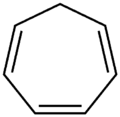- Cycloheptatriene
-
Cycloheptatriene  1,3,5-cycloheptatrieneOther namesCHT
1,3,5-cycloheptatrieneOther namesCHTIdentifiers CAS number 544-25-2 
ChemSpider 10534 
ChEBI CHEBI:37519 
Jmol-3D images Image 1 - C1=C\C/C=C\C=C1
Properties Molecular formula C7H8 Molar mass 92.14 g mol−1 Density 0.888 g/mL at 25 °C Melting point -80 °C, 193 K, -112 °F
Boiling point 116 °C, 389 K, 241 °F
Solubility in water Insoluble in water Hazards R-phrases R10 R11 R21 R23/24/25 R36/37/38 S-phrases S9 S16 S23 S28A S33 S36/37 S45  (verify) (what is:
(verify) (what is:  /
/ ?)
?)
Except where noted otherwise, data are given for materials in their standard state (at 25 °C, 100 kPa)Infobox references Cycloheptatriene (CHT) is an organic compound with the formula C7H8. This colourless liquid has been of recurring theoretical interest in organic chemistry. It is a ligand in organometallic chemistry and as a building block in organic synthesis. Cycloheptatriene is not aromatic, as reflected by the nonplanarity of the CH2 group with respect to the other atoms.
Contents
Synthesis
Albert Ladenburg first generated cycloheptatriene in 1881 by the decomposition of tropine.[1][2] The structure was finally proven by the synthesis of Richard Willstätter in 1901. This synthesis started from cycloheptanone and established the seven membered ring structure of the compound.[3]
Cycloheptatriene can be obtained in the laboratory by photochemical reaction of benzene with diazomethane or the pyrolysis of the adduct of cyclohexene and dichlorocarbene.[4] A related classic synthesis for a cycloheptatriene derivatives, the "Buchner ring enlargement, starts with the reaction of benzene with ethyl diazoacetate to give the corresponding norcaradiene carboxylic acid, which at high temperatures rearranges with ring expansion to the cycloheptatriene carboxylic acid ethyl ester.[5][6]
Reactions
Removal of a hydride ion from the methylene group gives the planar and aromatic cycloheptatriene cation, also called the tropylium ion. A practical route to this cation employs PCl5 as the oxidant.[7] CHT behaves as a diene in Diels–Alder reactions. Many metal complexes are known of CHT, such as Cr(CO)3(C7H8). [8]
Cyclooctatetraene and cycloheptatriene are used as a triplet quencher for rhodamine 6G dye lasers.[9][10]
See also
References
- ^ A. Ladenburg (1883). "Die Constitution des Atropins". Justus Liebig's Annalen der Chemie 217 (1): 74–149. doi:10.1002/jlac.18832170107.
- ^ A. Ladenburg (1881). "Die Zerlegung des Tropines". Berichte der Deutschen chemischen Gesellschaft 14 (2): 2126–2131. doi:10.1002/cber.188101402127. http://gallica.bnf.fr/ark:/12148/bpt6k906939/f537.chemindefer.
- ^ R. Willstätter (1901). "Synthesen in der Tropingruppe. I. Synthese des Tropilidens". Justus Liebig's Annalen der Chemie 317 (2): 204–265. doi:10.1002/jlac.19013170206.
- ^ H.E. Winberg (1959). "Synthesis of Cycloheptatriene". Journal of Organic Chemistry 24 (2): 264–265. doi:10.1021/jo01084a635.
- ^ Buchner, et al., Ber., 18, 2377 (1885);
- ^ For a variation: Studies on the Polymethylbenzenes. IX. Addition of Ethyl Diazoacetate to Durene Lee Irvin Smith, Pliny O. Tawney J. Am. Chem. Soc.; 1934; 56(10); 2167-2169. doi:10.1021/ja01325a054
- ^ Conrow, K. (1973). "Tropylium Fluoroborate". Organic Syntheses, Collected Volume 5,: 1138. http://www.orgsyn.org/orgsyn/pdfs/CV5P1138.pdf.
- ^ James H. Rigby, Kevin R. Fales (2004), "7α-ACETOXY-(1Hβ, 6Hβ)-BICYCLO[4.4.1UNDECA-2,4,8-TRIENE VIA CHROMIUM-MEDIATED HIGHER ORDER CYCLOADDITION"], Org. Synth., http://www.orgsyn.org/orgsyn/orgsyn/prepContent.asp?prep=CV10P0001; Coll. Vol. 10: 1
- ^ Tomi Nath Das, K. Indira Priyadarsini (1994). "Triplet of Cyclooctatetraene : Reactivity and Properties". Journal of Chemical Society Faraday Transaction 90 (7): 963–968. doi:10.1039/ft9949000963.
- ^ R. Pappalardo, H. Samelson, and A. Lempicki (1970). "Long Pulse Laser Emission From Rhodamine 6G Using Cyclooctatetraene". Applied Physics Letters 16 (7): 267–269. doi:10.1063/1.1653190.
External links
Categories:- Cycloalkenes
Wikimedia Foundation. 2010.
